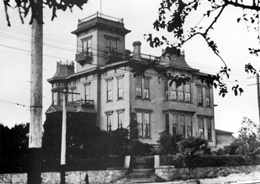This file contains Seattle historian and photographer Paul Dorpat's Now & Then photographs and reflections on Castlemount, the First Hill mansion of retired U.S. Army Colonel Granville O. Haller. It stood at the northeast corner of Minor Avenue and James Street.
The Haller Mansions
In 1883 the old Indian fighter Colonel Granville O. Haller retired from the service and built himself a mansion. It stood on the northeast corner of Minor Avenue and James Street on Seattle's First Hill -- a neighborhood that would soon become the city's first high-class community. The Hallers called their home "Castlemount." Its towering bulk did not so much grace the ridge behind Seattle as dominate it.
Pioneer Seattle historian Clarence Bagley's description of the colonel's physiognomy suits the facade of his home as well. "His broad brow indicated a strong intellect, his eye shone clear and bright and he was never afraid to look any man in the face." We can imagine the wide-eyed military man alert in his tower atop the "broad brow" of his castle looking at most of Seattle in the face.
After fighting the Seminoles in Florida and the Mexicans in Mexico City, Haller first came to the Northwest in 1853 to hunt down and sometimes hang insurrecting Indians.
In 1863, while fighting in the Civil War on the Union side, Haller, at a wine-tasting party with a few light-headed officers, made an imprudent but ambiguous remark that might have included Lincoln's name. A Navy man twisted the incident and caused Haller to be dismissed without a hearing for the "uttering of disloyal sentiments."
Haller fled his "unjust disgrace," came West again and settled first on Whidbey Island to raise a family. It took him 16 years to gain, by joint resolution of Congress, "complete exoneration," and reinstatement with the rank of colonel. In those years he raised a sizable fortune on Puget Sound. A model of pioneer enterprise, he worked it all -- real estate, lumbering, farming, and general merchandising -- out of a Coupeville store front.
The very well-off Granville Haller and his wife Henrietta lived together in their Castlemount for 14 years, until the colonel's death in 1897. By then they were surrounded by mansions, but no others reached the almost monolithic height of Castlemount.
Henrietta died in 1910 and the Haller's son Theodore was left to watch over (and down from) what during his tenure became known as the "Ghost House." And it seemed particularly haunted to Theodore's wife Constance.
When they married in 1917, Theodore was a 53-year-old businessman who was obsessed with frugally managing his sizable inheritance. Constance, 30 years his junior, lived in the mansion for 11 years, then took her husband to the divorce court complaining that she had to wear clothes inferior to her station, drive a second-hand automobile, and live in that great ghost house.
Judge James Ronald (1885-1951) granted the divorce. In his sympathetic words, "It was not pleasant for a young woman to be alone in that house day after day with nothing to look forward to but a game of dominoes in the evening. The mansion was once the finest in Seattle, its gingerbread scroll work highly regarded, and its furnishings considered the last work in luxury. But its windows did rattle, its floors were warped and cold. Naturally, Haller didn't notice it -- he was used to the house. Mrs. Haller was not."
The inconstant Constance was awarded a $30,000 settlement. Within two years Theodore was dead. Eventually, the mansion was razed, and during World War II, the government leased the grounds and put up a temporary and decidedly unluxurious housing project.

